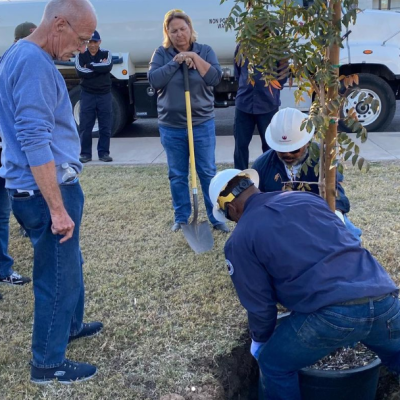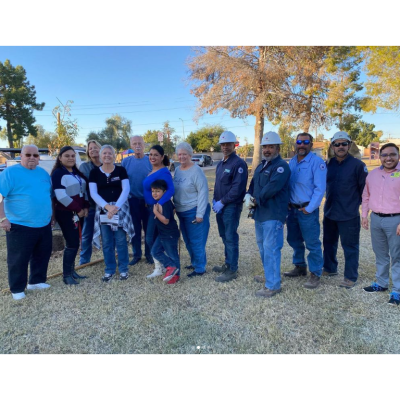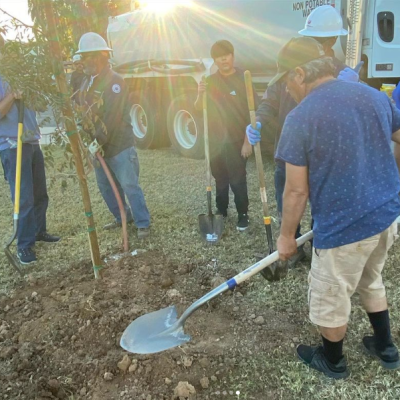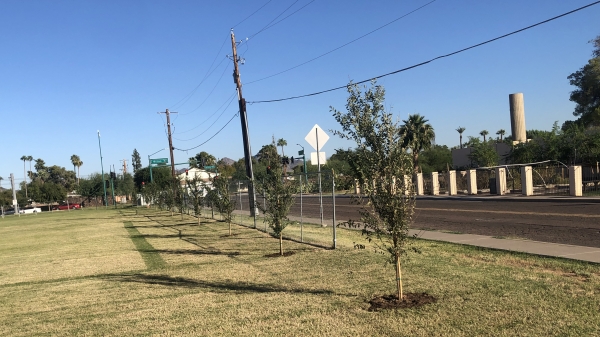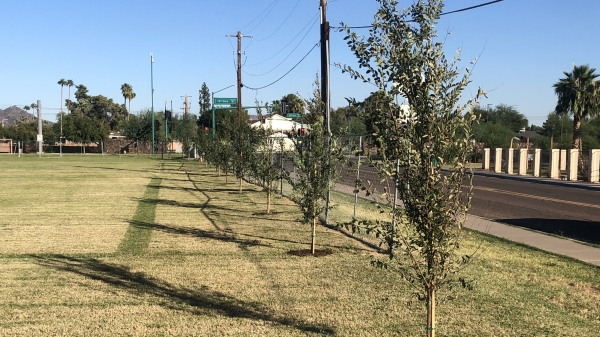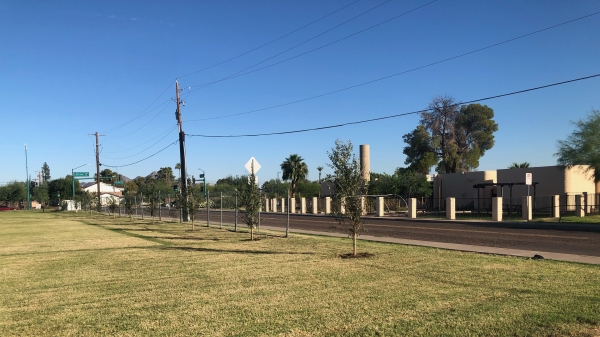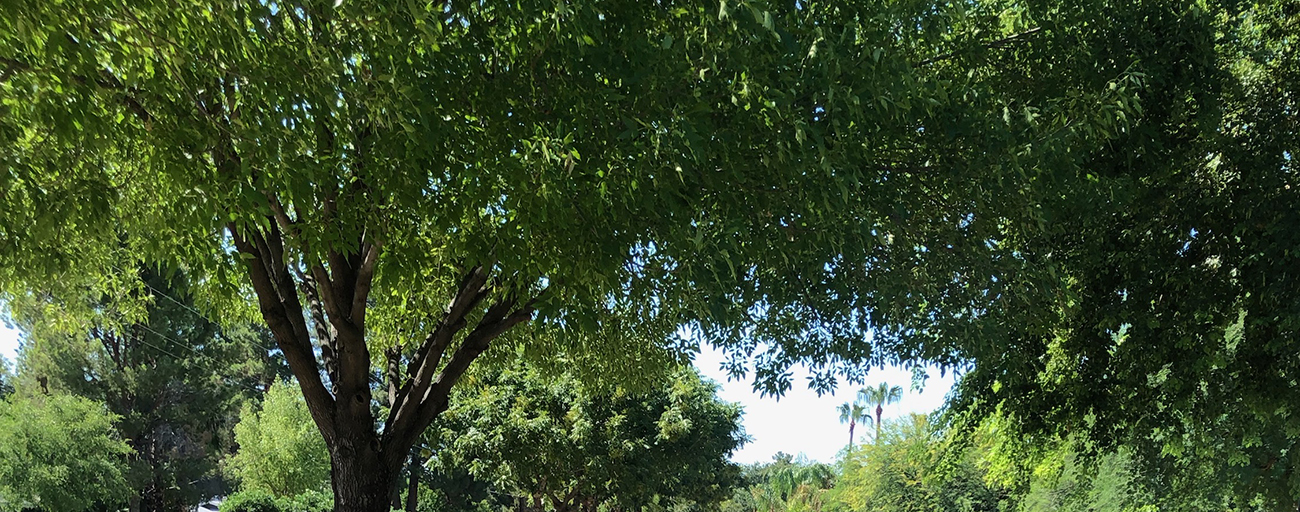
Prioritizing tree corridors to improve wellbeing
Michelle Litwin, City of Phoenix
"Creating safe walkable community begins with bringing community together, and shade is a great catalyst for that."
— Shannon McBride, 19North Vice President
Background
Each year, more Americans die from extreme heat than are killed by storms, floods and wildfires combined. City residents dependent on public and active transportation modes are inherently at higher risk for heat-related illness because of their higher daily exposure.
Rising temperatures worldwide create a growing concern for governing agencies and citizens alike, while urban areas face urban heat island effects like never before. Many cities are developing heat mitigation strategies to ensure public safety and comfort. Litwin closely examined one such strategy, cool corridors, and their implementation in one of the United States hottest large cities, Phoenix. She first defined cool corridors in Phoenix, then established a prioritization toolkit based on social, environmental and technological indicators. Recommended indicators for cool corridor prioritization included surface temperature, income and transit ridership. Supporting data sources included current city zoning, surveys, the UREx Urban Systems Lab and Valley Metro ridership data to support cool corridors' prioritization.
Phoenix was selected for this study due to its growing population, increased susceptibility to heat-related illnesses, accelerating investments in public transportation, and lack of G.I. Phoenix provides an opportunity to explore how local municipalities implement heat mitigation options to create safe and sustainable pedestrian corridors.
Research questions
What is the most effective and equitable way to prioritize and implement cool corridors in Phoenix?
Methods and findings
City residents dependent on public and active transportation modes are inherently at higher risk for heat-related illness because of their higher daily exposure. Finding solutions to minimize this exposure is essential to protect public health and address well-documented inequities in heat-related illness rates, which are typically higher among lower-income earners, racial and ethnic minorities, and other vulnerable populations (Harlan et al., 2013).
This study will examine how the city is currently prioritizing the selection of cool corridors and provide a process by which planners can establish prioritization. The research suggests that a corridor should meet five of seven proposed standards for cooling investments while also creating connectivity to public transportation, schools, business, and shops. Three corridors were selected in this study to evaluate the process and indicator standards. Following the process for evaluating corridors, this study discovered that some corridors might have elements that support prioritization, but achieving all factors is complex. Furthermore, the data to evaluate these elements is not currently available from one source. This study recommends creating a data platform with all the necessary data to evaluate and prioritize cool corridor selection.
Completing a literary review of heat mitigation strategies reveals that tree plantings as a part of cool corridor investments may increase community socialization and social cohesion and provide numerous health benefits. Combining green infrastructure with new cooling technologies will act as the framework for creating an optimal cool corridor. Evaluation of the cool corridor prioritization toolkit success and implementation in Phoenix may create a baseline for establishing successful global heat mitigation strategies.
This study examined the current information around cool corridors and determined that there is no working definition or comprehensive data to support equitable prioritization to apply cool corridors. While many agents are working in Phoenix, there is no collective method for prioritizing cool corridor selection. This study recommends examining social, environmental, and technological indicators as standards for prioritization. Cool corridors are natural or manmade channels between businesses, homes, schools, parks, and public transportation that provide sustainable, equitable, and safe routes—applying GIS from TreeKeeper, Valley Metro, StreetPHX UREx to establish a singular cool corridors prioritization map.
Partners
-
19North
-
Shannon McBride
-
-
Whitfill Nursery
-
Cindy Graber
-
-
Melisa Camp - Green Homes Phoenix
-
ASU:
-
David Hondula – [email protected] – Director – Office of Heat Response and Mitigation
-
Jenni Vanos – [email protected] - Assistant Professor - School of Sustainability ASU
-
Patricia Solis
-
Yuliya Dzyuban - Postdoctoral Researcher at Singapore Management University
-
Maggie Messerschmidt - Environmental Scientist and Project Manager, Climate Adaptation and Resilience
-
Impact
On June 26th, 1990, Phoenix experienced record-breaking temperatures reaching 122°F. This record still stands 31 years later, making it the city's hottest day to date. With an average high temperature of 110°F, August 2020 continued to break records and became the hottest month ever reported in The City of Phoenix. Each year Phoenix residents prepare to endure over 100 days of 100°F plus, excessive heat warnings, and intermittent power outages. The close study of physical and psychological implications shows alarming rates of heat on the human body. Research links extreme heat to premature mortality, a wide range of illnesses, violence, insomnia, depressive mood, and impaired cognitive function, among other outcomes (Cooper, 2019).
Residents with lower incomes and or living in poverty are of particular concern for heat-related health impacts. Among the factors contributing to higher risks for these residents is their higher likelihood of being outdoors when it is hot: local data suggest that somewhere between one-quarter and one-half of people living below the poverty line in Phoenix use public transportation (Goth, 2015). Absent or insufficient shade along transportation corridors further elevates risks to these residents as they navigate urban environments that are often hotter than their rural surroundings. In a study visualizing Arizona heat inequities, Reznick (2019) reports that people would have to "decide between keeping their home cool and paying for medical bills or rent," leading researchers to quantify this as a "health equity problem" (para. 16). Health equity falls under the social indicator and supports the need for equitable distribution of Phoenix's heat mitigation resources since those Phoenicians living in lower-income communities feel the heat more than those in higher socioeconomic situations. Green spaces act as a heat mitigation tool and strengthen community resilience while supporting positive mental and physical health.
The 2015 World Happiness Report establishes that happiness in one's community is essential in creating equitable policies. Furthermore, community-based indicators are more likely to respond to the community's needs appropriately. These indicators support community resilience, trust, social cohesion, and a robust built environment. Locally based social indicators should be unique to that community and identify the specific investments needed to address those characteristics. Greenwood et al. (2015) report that community indicators provide an opportunity to increase community engagement and establish a channel for community members to interact with policymakers. American Forests (2021) establishes that "ensuring equitable tree cover across every neighborhood can help address social inequities so that all people can thrive" (para. 1).
My Impact/ What I noticed:
This study's evaluation of current methods and data supports the conclusion that there is a gap in defining, prioritizing, and applying cool corridors in Phoenix. There is a variance in the equitable selection and distribution of resources to address the rising concern that is heat in Phoenix. Furthermore, while completing evaluations of selected corridors by ASU's Urban Climate Research Center, the disparities became clearer. Likewise, finding the data to support the call to action was difficult to locate. If cool corridor application is equitable, access to current information, policies, practices, and programming is necessary. Community input is one factor in establishing sustainable cool corridors.
Deliverables
A community “how to” on tree plantings. How to use the toolkit to support prioritizing your corridor planting, collaborative contacts, and process for completing a tree planting.
Michelle Litwin
Program Manager
City of Phoenix
Community Fellow, 2022
Michelle, a dynamic leader with a passion for urban heat and climate resilience, is the Heat Response Program Manager for the City of Phoenix Office of Heat Response and Mitigation. With a Bachelor of Science degree from Arizona State University and a Master of Science in Global Technology and Development from ASU, Michelle has a deep understanding of the challenges facing vulnerable communities worldwide. Her work focuses on increasing access to cooling resources, promoting public awareness, and advancing policies supporting heat adaptation and mitigation. Michelle's dedication to her community and her work has made her a respected leader and beloved member of the Phoenix community.
